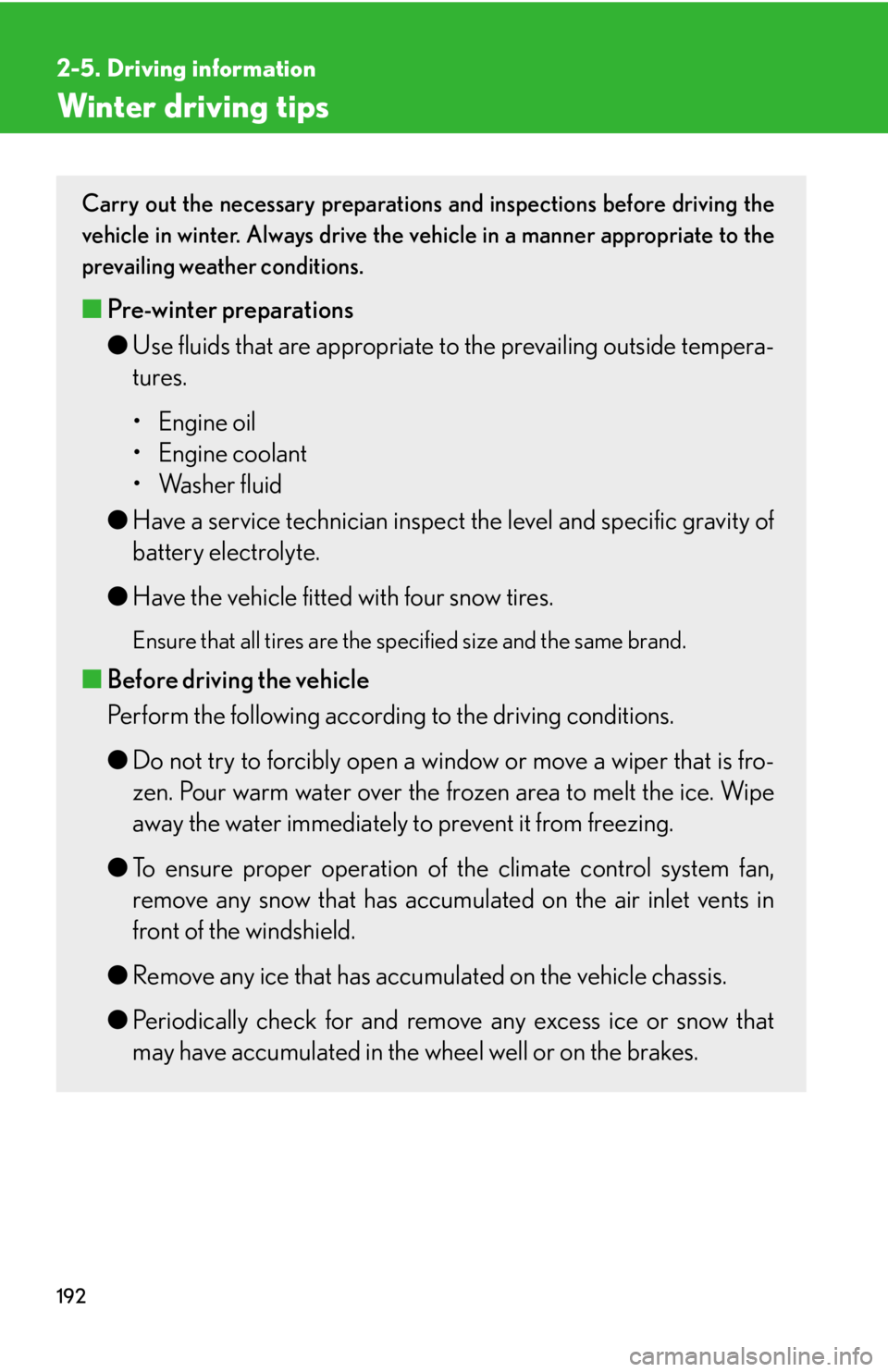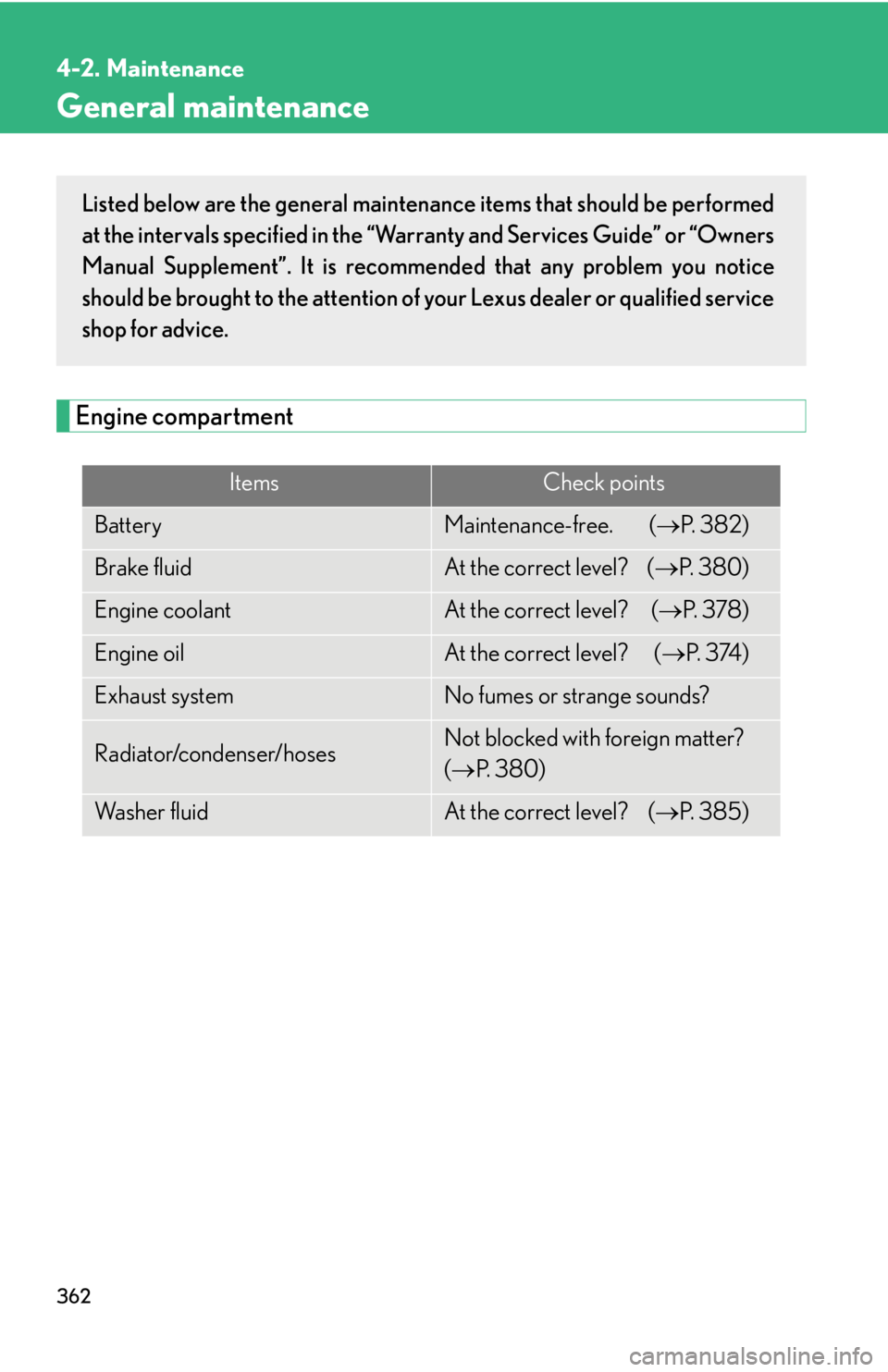coolant level Lexus IS F 2010 Audio/video System / LEXUS 2010 IS F OWNERS MANUAL (OM53A25U)
[x] Cancel search | Manufacturer: LEXUS, Model Year: 2010, Model line: IS F, Model: Lexus IS F 2010Pages: 543, PDF Size: 16.07 MB
Page 195 of 543

192
2-5. Driving information
Winter driving tips
Carry out the necessary preparations and inspections before driving the
vehicle in winter. Always drive the vehicle in a manner appropriate to the
prevailing weather conditions.
■Pre-winter preparations
●Use fluids that are appropriate to the prevailing outside tempera-
tures.
• Engine oil
• Engine coolant
• Washer fluid
●Have a service technician inspect the level and specific gravity of
battery electrolyte.
●Have the vehicle fitted with four snow tires.
Ensure that all tires are the specified size and the same brand.
■Before driving the vehicle
Perform the following according to the driving conditions.
●Do not try to forcibly open a window or move a wiper that is fro-
zen. Pour warm water over the frozen area to melt the ice. Wipe
away the water immediately to prevent it from freezing.
●To ensure proper operation of the climate control system fan,
remove any snow that has accumulated on the air inlet vents in
front of the windshield.
●Remove any ice that has accumulated on the vehicle chassis.
●Periodically check for and remove any excess ice or snow that
may have accumulated in the wheel well or on the brakes.
Page 365 of 543

362
4-2. Maintenance
General maintenance
Engine compartment
ItemsCheck points
BatteryMaintenance-free. (P. 3 8 2 )
Brake fluidAt the correct level? (P. 3 8 0 )
Engine coolantAt the correct level? (P. 3 7 8 )
Engine oilAt the correct level? (P. 3 74 )
Exhaust systemNo fumes or strange sounds?
Radiator/condenser/hosesNot blocked with foreign matter?
(P. 3 8 0 )
Wa s h e r f l u i dAt the correct level? (P. 3 8 5 )
Listed below are the general maintenance items that should be performed
at the intervals specified in the “Warranty and Services Guide” or “Owners
Manual Supplement”. It is recommended that any problem you notice
should be brought to the attention of your Lexus dealer or qualified service
shop for advice.
Page 369 of 543

366
4-3. Do-it-yourself maintenance
Do-it-yourself service precautions
If you perform maintenance yourself, be sure to follow the correct proce-
dure as given in these sections.
ItemsPa r t s a n d t o o l s
Battery condition (P. 3 8 2)
•Warm water
• Baking soda
•Grease
• Conventional wrench
(for terminal clamp bolts)
Brake fluid level (P. 3 8 0 )
• FMVSS No.116 DOT 3 or SAE
J1703 brake fluid
•Rag or paper towel
• Funnel (used only for adding brake
fluid)
Engine coolant level (P. 3 7 8 )
• “Toyota Super Long Life Coolant”
or similar high-quality ethylene gly-
col-based non-silicate, non-amine,
non-nitrite and non-borate coolant
with long-life hybrid organic acid
technology.
For the U.S.A.:
“Toyota Super Long Life Coolant”
is pre-mixed with 50% coolant and
50% deionized water.
For Canada:
“Toyota Super Long Life Coolant”
is pre-mixed with 55% coolant and
45% deionized water.
• Funnel (used only for adding
engine coolant)
Page 375 of 543

372
4-3. Do-it-yourself maintenance
Engine compartment
Battery (P. 382)
Engine oil level dipstick
(P. 3 74 )
Engine oil filler cap
(P. 3 74 )
Brake fluid reservoir
(P. 380)
Fuse boxes (P. 4 0 8 )Washer fluid tank
(P. 385)
Electric cooling fans
Condenser (P. 380)
Radiator (P. 380)
Engine coolant reservoir
(P. 3 7 8 )
Page 381 of 543

378
4-3. Do-it-yourself maintenance
Engine coolant
The coolant level is satisfactory if it is between the “FULL” and “LOW”
lines on the reservoir when the engine is cold.
Reservoir cap
“FULL”
“LOW”
If the level is on or below the
“LOW” line, add coolant up to the
“FULL” line.
Page 382 of 543

379
4-3. Do-it-yourself maintenance
4
Maintenance and care
■If the coolant level drops within a short time after replenishing
Visually check the radiator, hoses, coolant reservoir cap, drain cock and water
pump.
If you cannot find a leak, have your Lexus dealer test the cap and check for leaks in
the cooling system.
■Coolant selection
Only use “Toyota Super Long Life Coolant” or similar high-quality ethylene glycol-
based non-silicate, non-amine, non-nitrite, and non-borate coolant with long-life
hybrid organic acid technology.
U.S.A.: “Toyota Super Long Life Coolant” is a mixture of 50% coolant and 50%
deionized water. (Enabled: -31F [-35C])
Canada: “Toyota Super Long Life Coolant” is a mixture of 55% coolant and 45%
deionized water. (Enabled: -44F [-42C])
For more details about engine coolant, contact your Lexus dealer.
CAUTION
■When the engine is hot
Do not remove the coolant reservoir cap.
The cooling system may be under pressure and may spray hot coolant if the cap is
removed, causing burns or other injuries.
NOTICE
■When adding engine coolant
Coolant is neither plain water nor straight antifreeze. The correct mixture of water
and antifreeze must be used to provide proper lubrication, corrosion protection
and cooling. Be sure to read the antifreeze or coolant label.
■If you spill coolant
Be sure to wash it off with water to prevent damage to parts or paint.
Page 440 of 543

5
When trouble arises
437
5-1. Essential information
If you think something is wrong
If you notice any of the following symptoms, your vehicle probably needs
adjustment or repair. Contact your Lexus dealer as soon as possible.
■Visible symptoms
●Fluid leaks under the vehicle
(Water dripping from the air conditioning after use is normal.)
●Flat-looking tires or uneven tire wear
●Engine coolant temperature gauge needle continually points
higher than normal
■Audible symptoms
●Changes in exhaust sound
●Excessive tire squeal when cornering
●Strange noises related to the suspension system
●Pinging or other noises related to the engine
■Operational symptoms
●Engine missing, stumbling or running rough
●Appreciable loss of power
●Vehicle pulls heavily to one side when braking
●Vehicle pulls heavily to one side when driving on a level road
●Loss of brake effectiveness, spongy feeling, pedal almost touches
the floor
Page 486 of 543

5
When trouble arises
483
5-2. Steps to take in an emergency
If your vehicle overheats
If your engine overheats:
Stop the vehicle in a safe place and turn off the automatic air
conditioning system.
Check to see if steam is coming out from under the hood.
If you see steam:
Stop the engine. Carefully lift the hood after the steam sub-
sides and then restart the engine.
If you do not see steam:
Leave the engine running and carefully lift the hood.
Remove the engine compartment cover (front). (P. 3 7 3 )
Check to see if the cooling fans are operating.
If the fans are operating:
Wait until the temperature of the engine (shown on the
instrument cluster) begins to fall and then stop the engine.
If the fans are not operating:
Stop the engine immediately and call your local Lexus
dealer.
After the engine has cooled
down sufficiently, check the
engine coolant level and inspect
the radiator core (radiator) for
any leaks.STEP1
STEP2
STEP3
STEP4
STEP5
Page 512 of 543

509
6-1. Specifications
6
Vehicle specifications
Curb weight
The weight of a motor vehicle with standard equip-
ment, including the maximum capacity of fuel, oil and
coolant, and if so equipped, air conditioning and
additional weight optional engine
Maximum loaded vehicle
weight
The sum of:
(a) Curb weight
(b) Accessory weight
(c) Vehicle capacity weight
(d) Production options weight
Normal occupant weight150 lb. (68 kg) times the number of occupants speci-
fied in the second column of Table 1
* that follows
Occupant distributionDistribution of occupants in a vehicle as specified in
the third column of Table 1
* below
Production options
weight
The combined weight of installed regular production
options weighing over 5 lb. (2.3 kg) in excess of the
standard items which they replace, not previously
considered in curb weight or accessory weight,
including heavy duty brakes, ride levelers, roof rack,
heavy duty battery, and special trim
RimA metal support for a tire or a tire and tube assembly
upon which the tire beads are seated
Rim diameter
(Wheel diameter)Nominal diameter of the bead seat
Rim size designationRim diameter and width
Rim type designationThe industry manufacturer's designation for a rim by
style or code
Rim widthNominal distance between rim flanges
Vehicle capacity weight
(Total load capacity)The rated cargo and luggage load plus 150 lb. (68
kg) times the vehicle's designated seating capacity
Tire related termMeaning